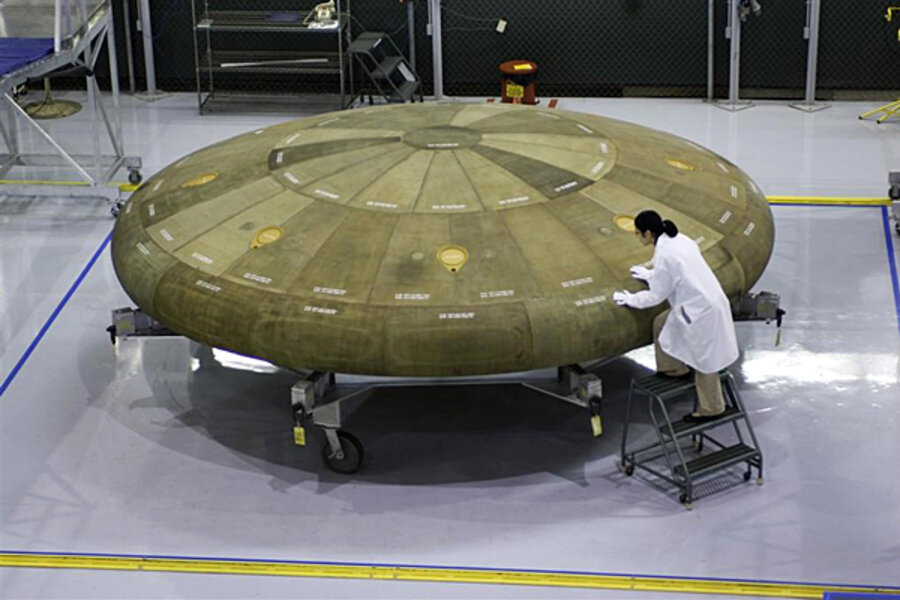Space shuttle successor to be built by Boeing?
As NASA's space shuttle fleet draws close to retirement, aerospace juggernaut Boeing is hard at work developing a new capsule-based spaceship to fly people to and from the International Space Station.
The new Boeing space capsule is a project using the company's recent $18 million award from NASA to advance the concepts and technology necessary to build a commercial crew space transportation system. It is one of several efforts by different U.S. companies to come with new spaceships to fill the void left by NASA's retiring shuttles.
And so far, things have been progressing right on schedule, said Keith Reiley, Boeing's Commercial Crew Development Program Manager.
IN PICTURES: NASA's Future of Space Exploration
"We're right on schedule for all of our demonstrations," Reiley told SPACE.com. "We've done 50 to 60 percent of our milestones, and all of them have been on time or ahead of time."
Boeing's new spaceship
At the heart of Boeing's new spaceship design is the CST-100 capsule, which will look similar to the cone-shaped Apollo and Orion spacecraft.
The Apollo capsules were built to ferry astronauts between Earth and lunar orbit in the late 1960s and 1970s. The larger Orion vehicles were part of NASA's Constellation program to return astronauts to the moon, and are now slated to serve as a space station lifeboat.
"It's a little smaller than Orion, but a little bigger than Apollo," Reiley said of the CST-100 spacecraft. "It carries seven, but it's fairly small – it's not as large or as spacious as the Orion."
The capsule is being built for short missions to the space station, meaning it will not be designed to stay in space for long periods of time.
Multiple rocket rides
Boeing plans to launch the CST-100 capsule from Florida, but has yet to determine which rocket will carry it into space.
The spacecraft is being designed for compatibility with a variety of rockets, in much the same way that commercial satellites are. This will give Boeing the flexibility to select an appropriate rocket later in the development process.
And while NASA has outlined a launch target for 2016, the new capsule could be rolled out sooner than expected, which could help fill the gap in future human spaceflight should NASA scrap its Constellation program.
"We haven't laid out our exact timeline yet, but we do have a schedule, and it beats the 2016 that was NASA's goal," Reiley said.
Private space station ferries
NASA isn't the only customer Boeing has in mind for the CST-100. The company has teamed up with Bigelow Aerospace, a Las Vegas-based company that recently joined the Commercial Spaceflight Federation.
Bigelow Aerospace is developing private inflatable space habitats with the goal of launching a commercial space station in 2014. The company has already launched two prototype modules into space.
For the new CST-100 spacecraft, Bigelow Aerospace will assist with demonstrations and design work in areas where they have cultivated experience from the design and construction of their orbital facilities and commercial space complex, said Reiley. The partnership also represents an important stepping stone for the commercial spaceflight industry.
"The future is being created now," said Bigelow Aerospace founder and president Robert Bigelow in a statement. "Commercial crew transportation has the potential to revolutionize the space industry for public and private sector entities alike."
Bigelow, who owns the Budget Suites of America hotel chain, also sees the vast potential for synergistic collaboration between his company and the veteran Boeing, which has been developing human and robotic space vehicles and their accompanying hardware for over 50 years.
"Boeing's unparalleled heritage and experience, combined with Bigelow Aerospace's entrepreneurial spirit and desire to keep costs low, represents the best of both established and new space companies," Bigelow said. "The product of this relationship, the CST-100 capsule, will represent the safest, most reliable, and most cost-effective spacecraft ever to fly."
Keep it affordable
For Boeing, one of their main challenges in expanding their branch of commercial spaceflight is in designing a relatively inexpensive option.
"I think one of the big challenges for Boeing, in particular, is to try to do things quicker and less expensive," Reiley said. "We learned a lot from Bigelow on how to do that."
Both Reiley and Bigelow agree that the inaugural launch of the private Falcon 9 rocket and Dragon capsule by the California-based company SpaceX represented a great stride made in commercial spaceflight. [Photos of the historic Falcon 9 launch]
"The unprecedented success of the Falcon 9's inaugural launch clearly demonstrates that it's possible to dramatically reduce the cost of human spaceflight operations," Bigelow said. "SpaceX's Falcon 9 rocket and Dragon capsule were developed at a cost dramatically below that of traditional cost-plus programs – this should be a wakeup call that it's time for a new way of doing business."
And, with months and years of demonstrations and tests on the horizon for Boeing, the company can look to the successful launch of Falcon 9 as inspiration and motivation.
"It's always good to see folks succeed in spaceflight," Reiley said. "It certainly provides an impetus for all commercial providers to continue working hard."





